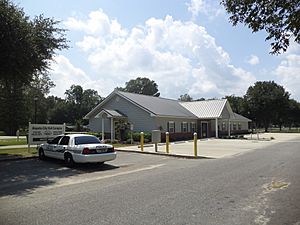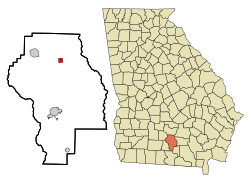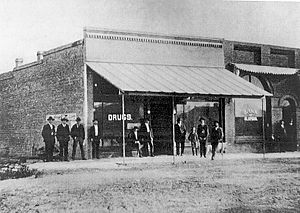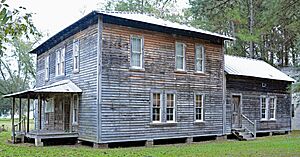Alapaha, Georgia facts for kids
Quick facts for kids
Alapaha, Georgia
|
|
|---|---|

Alapaha City Hall
|
|

Location in Berrien County and the state of Georgia
|
|
| Country | United States |
| State | Georgia |
| County | Berrien |
| Area | |
| • Total | 1.03 sq mi (2.66 km2) |
| • Land | 1.03 sq mi (2.66 km2) |
| • Water | 0.00 sq mi (0.00 km2) |
| Elevation | 285 ft (87 m) |
| Population
(2020)
|
|
| • Total | 481 |
| • Density | 468.35/sq mi (180.80/km2) |
| Time zone | UTC-5 (Eastern (EST)) |
| • Summer (DST) | UTC-4 (EDT) |
| ZIP code |
31622
|
| Area code(s) | 229 |
| FIPS code | 13-01024 |
| GNIS feature ID | 0331009 |
Alapaha is a small town in Berrien County, Georgia, United States. It is located along the Alapaha River. In 2020, about 481 people lived there.
Alapaha started as a trading spot. It was built on the site of an old Seminole village with the same name. Interestingly, the town of Lakeland was first called "Alapaha" before this town got its name.
Contents
What Does Alapaha Mean?
The name "Alapaha" has been around for a long time. It was used for both a river and a village in the mid-1800s. People back then weren't sure how to say it, or what it meant.
Some experts think "Alapaha" comes from the Creek language. It might have meant "other side." Others believe it came from the Timucua language and meant "bear." One expert thought it was a Creek version of the Timucuan word "arapaha," meaning "bear lodge." A Timucua town called Arapaha likely gave its name to the river. People speaking Muscogean languages might have changed "Arapaha" to "Alapaha" because their language didn't have the "r" sound.
History of Alapaha
Early Times and Native Americans
In 1886, the Smithsonian Institution found an ancient Indian mound near Alapaha. It was about 5 miles (8 km) northeast of town, by the Alapaha River. The mound was 38 feet (12 m) wide and 6 feet (2 m) tall. Inside, there was a burial area with two bodies. These remains might have become part of the Smithsonian's collection.
Early European settlers in the area were mostly Highland Scots. They were often Methodist or Primitive Baptist. These settlers were farmers who came from the Georgia Land Lottery of 1820. Between 1820 and 1840, people mainly raised sheep and cattle. When railroads expanded in the 1830s, many Irish Catholic workers moved to the area. They helped build St. Anne's Catholic church.
The town of Alapaha became a train stop on the Brunswick and Albany Railroad. This was near where a road from Nashville, Georgia crossed the Alapaha River. It was known as "Alapaha Station" by 1874.
Boom Years and Growth
The 1880s and 1890s were a time of growth for Alapaha. The town saw a boom in forestry, timber, and naval stores (products from pine trees). Several sawmills opened in Alapaha by 1880. One, "Alapaha Steam Saw Mills," even advertised in the New York Times. They sold high-quality pine wood.
In 1881, a pamphlet promoted Alapaha as a great place for business. It called Alapaha "an important wool market" and a "lively little village." The town had six stores, three bars, two doctors, two lawyers, and one dentist. It even had its own newspaper. The pamphlet also mentioned that honey from Alapaha was very rich.
In 1886, the Macon Telegraph newspaper wrote about Alapaha's new hotel. It was a two-story building, well-kept by Dr. J.A. Fogle and his wife. Guests, including traveling salespeople, loved the clean rooms and good food. This building is still standing today as a private home.
In 1897, a big fire destroyed four buildings in downtown Alapaha. The Macon Telegraph reported that people from both black and white communities worked together to fight the fire. The cause of the fire was unknown, but many thought it was set on purpose.
Alapaha in the 20th Century
In 1907, two doctors from Alapaha, W.A. Moore and G.A. Paulk, were listed in the Georgia Medical Association.
Alapaha was the site of a famous train wreck on March 26, 1911. The Dixie Flyer train crashed on a high bridge over the Alapaha River. Ten people died, and many were hurt.
In 1914, Robert Alex Rutland, an inventor from Alapaha, got a patent for a "portable shower-bath." This shows the clever ideas coming from the town.
During World War I, a cargo ship named Alapaha was launched in 1918. It carried goods like coal between Philadelphia and France. The ship faced rough seas and strikes but survived.
Alapaha lost four men in the Otranto troopship disaster in 1918. This happened off the coast of Scotland, just before World War I ended. Their names were James Malcolm McMillan, Arthur Harper, William Hayes, and B.F. McCranie.
The Alapaha Colored School was very important for African American children. It was the only school for them in the northern part of Berrien County for 30 years. It had four classrooms and two stories. The school closed in 1954 when other schools were combined in Nashville.
On May 11, 1952, a tornado hit Alapaha. It badly damaged the town's business area and smashed the water tower. The Red Cross came to help the town recover.
In 1966, Army Master Sgt. James Emory Jones from Alapaha was killed. He was part of a secret unit called MAC-SOG during the Vietnam War. This unit did secret missions outside Vietnam. Jones's team was ambushed, and he was listed as "missing in action" for many years.
The 1996 novel The Wonder Book of the Air by Cynthia Shearer is set in Alapaha. It includes many details about the town's history.
Just outside Alapaha is where "Hogzilla" was shot in 2004. Hogzilla was a huge wild hog weighing about 800 pounds (360 kg). Its remains were even dug up for a National Geographic TV special.
Geography and Climate
Alapaha covers about 1.0 square mile (2.6 km2) of land. There is no water area within the town limits.
Climate in Alapaha
Alapaha has a humid subtropical climate. This means it has warm temperatures and rain throughout the year. On climate maps, this is shown as "Cfa."
| Climate data for Alapaha, Georgia | |||||||||||||
|---|---|---|---|---|---|---|---|---|---|---|---|---|---|
| Month | Jan | Feb | Mar | Apr | May | Jun | Jul | Aug | Sep | Oct | Nov | Dec | Year |
| Mean daily maximum °F (°C) | 63.2 (17.3) |
64.9 (18.3) |
71.4 (21.9) |
78.7 (25.9) |
85.8 (29.9) |
90.7 (32.6) |
91.7 (33.2) |
91.7 (33.2) |
88.3 (31.3) |
80.5 (26.9) |
71.0 (21.7) |
63.7 (17.6) |
78.5 (25.8) |
| Mean daily minimum °F (°C) | 39.3 (4.1) |
40.9 (4.9) |
46.8 (8.2) |
53.5 (11.9) |
61.2 (16.2) |
67.8 (19.9) |
70.1 (21.2) |
69.8 (21.0) |
65.9 (18.8) |
55.0 (12.8) |
44.7 (7.1) |
39.5 (4.2) |
54.6 (12.6) |
| Average precipitation inches (mm) | 3.7 (94) |
4.4 (110) |
4.5 (110) |
3.7 (94) |
3.8 (97) |
4.8 (120) |
5.8 (150) |
5.3 (130) |
4.1 (100) |
2.1 (53) |
1.8 (46) |
3.8 (97) |
47.8 (1,210) |
| Source: Weatherbase | |||||||||||||
Population of Alapaha
| Historical population | |||
|---|---|---|---|
| Census | Pop. | %± | |
| 1880 | 157 | — | |
| 1890 | 449 | 186.0% | |
| 1900 | 429 | −4.5% | |
| 1910 | 532 | 24.0% | |
| 1920 | 503 | −5.5% | |
| 1930 | 270 | −46.3% | |
| 1940 | 494 | 83.0% | |
| 1950 | 505 | 2.2% | |
| 1960 | 631 | 25.0% | |
| 1970 | 633 | 0.3% | |
| 1980 | 771 | 21.8% | |
| 1990 | 812 | 5.3% | |
| 2000 | 682 | −16.0% | |
| 2010 | 668 | −2.1% | |
| 2020 | 481 | −28.0% | |
| U.S. Decennial Census 1850-1870 1880 1890-1910 1920-1930 1930-1940 1940-1950 1960-19801980-2000 2010 2020 |
|||
| Race / Ethnicity (NH = Non-Hispanic) | Pop 2010 | Pop 2020 | % 2010 | % 2020 |
|---|---|---|---|---|
| White alone (NH) | 233 | 168 | 34.88% | 34.93% |
| Black or African American alone (NH) | 407 | 259 | 60.93% | 53.85% |
| Native American or Alaska Native alone (NH) | 1 | 0 | 0.15% | 0.00% |
| Asian alone (NH) | 1 | 0 | 0.15% | 0.00% |
| Pacific Islander alone (NH) | 0 | 1 | 0.00% | 0.21% |
| Some Other Race alone (NH) | 0 | 0 | 0.00% | 0.00% |
| Mixed Race or Multi-Racial (NH) | 3 | 43 | 0.45% | 8.94% |
| Hispanic or Latino (any race) | 23 | 10 | 3.44% | 2.08% |
| Total | 668 | 481 | 100.00% | 100.00% |
In 2010, Alapaha had 668 residents. By 2020, the population had gone down to 481 people.
See also
 In Spanish: Alapaha para niños
In Spanish: Alapaha para niños



